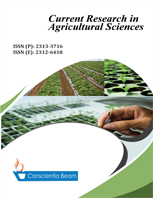Comparative Analysis of Reference Evapotranspiration by Hargreaves and Blaney-Criddle Equations in Semi-Arid Climatic Conditions
DOI:
https://doi.org/10.18488/journal.68.2020.72.52.57Abstract
There are various equations for calculation of reference evapotranspiration (ETo), but the Penman-Monteith (PM FAO-56) equation has been considered as the standard ETo equation. The key problem of PM FAO-56 equation is that it uses large number of weather parameters like air temperature, wind velocity, humidity and sun radiation as input. These weather parameters are not accessible at all weather stations of the world especially in developing countries. So, ablatives ETo equations like Hargreaves (HG) and Blaney-Criddle (BC) equations are used for estimation of ETo which required very small number of weather parameters that are readily available at most of the weather stations of the world. A research is conducted to compare HG and BC ETo equations for estimation of monthly ETo under semi-arid climatic regions of Lahore, Faisalabad and Peshawar, Pakistan. The PM FAO-56 ETo equation is considered as reference ETo equation for the assessment of HG ETo and BC ETo equation. The statistical results indicate that HG ETo equation overestimates PM FAO-56 ETo method by 7.91% at Lahore weather station, 5.59 % at Faisalabad weather station and 11.95% at Peshawar weather station. The BC ETo equation overestimates PM FAO-56 ETo equation by 34.345% at Lahore weather station, 28.637% at Faisalabad weather station and 21.44% at Peshawar weather station. The variation of HG ETo equation with PM FAO-56 ETo equation with RMSE of 0.487 mm/day at Lahore weather station, 0.521 mm/day at Faisalabad weather station and 0.985 at Peshawar weather station is noted. The variation of BC ETo equation with PM FAO-56 ETo equation having RMSE of 3.03 at Lahore weather station, 2.58 at Faisalabad weather station and 1.96 at Peshawar weather station is noted.

